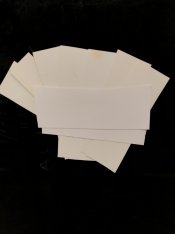Grim Tuesday
Member
I was messing around in the darkroom last night with a large expired paper stock I got from Craigslist (circa 2011-2014, not stored properly) and am finding that most of the Agfa papers are fogged with age. The max highlights are some level of gray. The Ilford papers seem different -- they have no gray but seem to have yellow around the edges. FB paper especially, which is sad because I have 150 sheets of it in 8x10. I then went back to my trusty, almost-in-date Arista paper that I've had success with before, and ended up with a yellow spot on it as well! Which made me think that there might not be anything wrong with the paper, and it is something up in my processing, or something on my tongs! I am using PF Liquidol to develop (the stock solution was a few months old, but seemed to work in every other way), tap water to stop, and a fresh batch of TF-4 to fix. I am going to mix a fresh batch of developer tonight and see if anything changes, but in the mean time any thoughts on what could have gone wrong? One other potential clue: I left a piece of the Arista paper in the developer while I was cleaning up and it developed an odd, black iridescence, in a chemigram kind of way.











